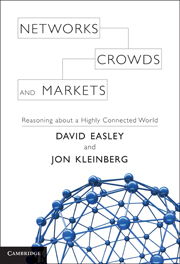Crossref Citations
This Book has been
cited by the following publications. This list is generated based on data provided by Crossref.
Amer-Yahia, Sihem
Doan, AnHai
Kleinberg, Jon
Koudas, Nick
and
Franklin, Michael
2010.
Crowds, clouds, and algorithms.
p.
1259.
Oyama, Daisuke
and
Takahashi, Satoru
2010.
Contagion and Uninvadability in Social Networks with Bilingual Option.
SSRN Electronic Journal,
Colbaugh, Richard
Glass, Kristin
and
Ormerod, Paul
2010.
Advances in Social Computing.
Vol. 6007,
Issue. ,
p.
79.
Kleinberg, Jon
2010.
The flow of on-line information in global networks.
p.
1.
2010.
Publications Received.
Contemporary Sociology: A Journal of Reviews,
Vol. 39,
Issue. 6,
p.
766.
Colbaugh, Richard
and
Glass, Kristin
2010.
Early warning analysis for social diffusion events.
p.
37.
Kuhlman, Chris J.
Anil Kumar, V. S.
Marathe, Madhav V.
Ravi, S. S.
and
Rosenkrantz, Daniel J.
2010.
Machine Learning and Knowledge Discovery in Databases.
Vol. 6322,
Issue. ,
p.
111.
Szell, Michael
Lambiotte, Renaud
and
Thurner, Stefan
2010.
Multirelational organization of large-scale social networks in an online world.
Proceedings of the National Academy of Sciences,
Vol. 107,
Issue. 31,
p.
13636.
Cabanac, Guillaume
2011.
Accuracy of inter-researcher similarity measures based on topical and social clues.
Scientometrics,
Vol. 87,
Issue. 3,
p.
597.
Xu, Bin
Chin, Alvin
Wang, Hao
Chang, Lele
Zhang, Ke
Yin, Fangxi
and
Zhang, Li
2011.
Physical Proximity and Online User Behaviour in an Indoor Mobile Social Networking Application.
p.
273.
Mustafaraj, Eni
Finn, Samantha
Whitlock, Carolyn
and
Metaxas, Panagiotis T.
2011.
Vocal Minority Versus Silent Majority: Discovering the Opionions of the Long Tail.
p.
103.
Yusof, Siti Zarinah Mohd
Asirvadam, Vijanth Sagayan
and
Hassan, Mohd Fadzil
2011.
Representing pre-trip transit information as graph with constraints.
p.
1.
Sridharan, Ajay
Gao, Yong
Wu, Kui
and
Nastos, James
2011.
Statistical behavior of embeddedness and communities of overlapping cliques in online social networks.
p.
546.
Qiu, Liangfei
Rui, Huaxia
and
Whinston, Andrew B.
2011.
A Twitter-Based Prediction Market: Social Network Approach.
SSRN Electronic Journal,
Navlakha, Saket
and
Bar‐Joseph, Ziv
2011.
Algorithms in nature: the convergence of systems biology and computational thinking.
Molecular Systems Biology,
Vol. 7,
Issue. 1,
Eslami, Motahhare
Rabiee, Hamid R.
and
Salehi, Mostafa
2011.
DNE: A Method for Extracting Cascaded Diffusion Networks from Social Networks.
p.
41.
Krause, Ulrich
2011.
Complex Economics. Individual and Collective Rationality.
The European Journal of the History of Economic Thought,
Vol. 18,
Issue. 3,
p.
471.
Bonchi, Francesco
Castillo, Carlos
Gionis, Aristides
and
Jaimes, Alejandro
2011.
Social Network Analysis and Mining for Business Applications.
ACM Transactions on Intelligent Systems and Technology,
Vol. 2,
Issue. 3,
p.
1.
Zweig, Katharina
2011.
Good versus optimal: Why network analytic methods need more systematic evaluation.
Open Computer Science,
Vol. 1,
Issue. 1,
Yin, Hongzhi
Cui, Bin
and
Huang, Yuxin
2011.
Advanced Data Mining and Applications.
Vol. 7120,
Issue. ,
p.
381.



